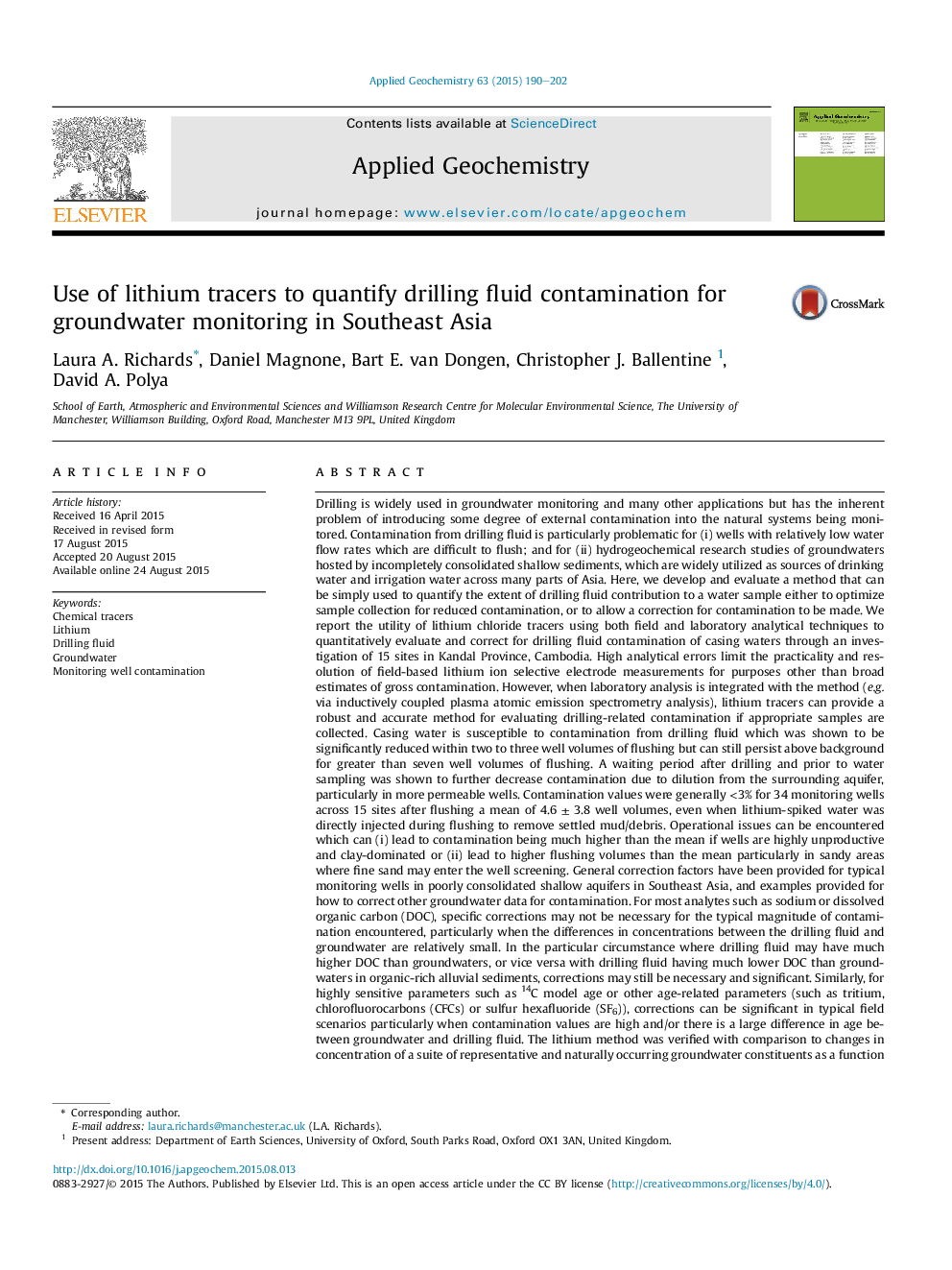| کد مقاله | کد نشریه | سال انتشار | مقاله انگلیسی | نسخه تمام متن |
|---|---|---|---|---|
| 6334942 | 1620228 | 2015 | 13 صفحه PDF | دانلود رایگان |
- Drilling-related contamination of groundwater from monitoring wells is quantified.
- Contamination after flushing is generally low, across various sites and lithology.
- Contamination is highest in low permeability wells that are difficult to flush.
- Methods to correct for contamination for geochemical interpretation are described.
- Age-related parameters such as 14C are particularly susceptible to contamination.
Drilling is widely used in groundwater monitoring and many other applications but has the inherent problem of introducing some degree of external contamination into the natural systems being monitored. Contamination from drilling fluid is particularly problematic for (i) wells with relatively low water flow rates which are difficult to flush; and for (ii) hydrogeochemical research studies of groundwaters hosted by incompletely consolidated shallow sediments, which are widely utilized as sources of drinking water and irrigation water across many parts of Asia. Here, we develop and evaluate a method that can be simply used to quantify the extent of drilling fluid contribution to a water sample either to optimize sample collection for reduced contamination, or to allow a correction for contamination to be made. We report the utility of lithium chloride tracers using both field and laboratory analytical techniques to quantitatively evaluate and correct for drilling fluid contamination of casing waters through an investigation of 15 sites in Kandal Province, Cambodia. High analytical errors limit the practicality and resolution of field-based lithium ion selective electrode measurements for purposes other than broad estimates of gross contamination. However, when laboratory analysis is integrated with the method (e.g. via inductively coupled plasma atomic emission spectrometry analysis), lithium tracers can provide a robust and accurate method for evaluating drilling-related contamination if appropriate samples are collected. Casing water is susceptible to contamination from drilling fluid which was shown to be significantly reduced within two to three well volumes of flushing but can still persist above background for greater than seven well volumes of flushing. A waiting period after drilling and prior to water sampling was shown to further decrease contamination due to dilution from the surrounding aquifer, particularly in more permeable wells. Contamination values were generally <3% for 34 monitoring wells across 15 sites after flushing a mean of 4.6 ± 3.8 well volumes, even when lithium-spiked water was directly injected during flushing to remove settled mud/debris. Operational issues can be encountered which can (i) lead to contamination being much higher than the mean if wells are highly unproductive and clay-dominated or (ii) lead to higher flushing volumes than the mean particularly in sandy areas where fine sand may enter the well screening. General correction factors have been provided for typical monitoring wells in poorly consolidated shallow aquifers in Southeast Asia, and examples provided for how to correct other groundwater data for contamination. For most analytes such as sodium or dissolved organic carbon (DOC), specific corrections may not be necessary for the typical magnitude of contamination encountered, particularly when the differences in concentrations between the drilling fluid and groundwater are relatively small. In the particular circumstance where drilling fluid may have much higher DOC than groundwaters, or vice versa with drilling fluid having much lower DOC than groundwaters in organic-rich alluvial sediments, corrections may still be necessary and significant. Similarly, for highly sensitive parameters such as 14C model age or other age-related parameters (such as tritium, chlorofluorocarbons (CFCs) or sulfur hexafluoride (SF6)), corrections can be significant in typical field scenarios particularly when contamination values are high and/or there is a large difference in age between groundwater and drilling fluid. The lithium method was verified with comparison to changes in concentration of a suite of representative and naturally occurring groundwater constituents as a function of well flushing from relatively low and high permeability groundwater monitoring wells to further illustrate the technique.
Journal: Applied Geochemistry - Volume 63, December 2015, Pages 190-202
